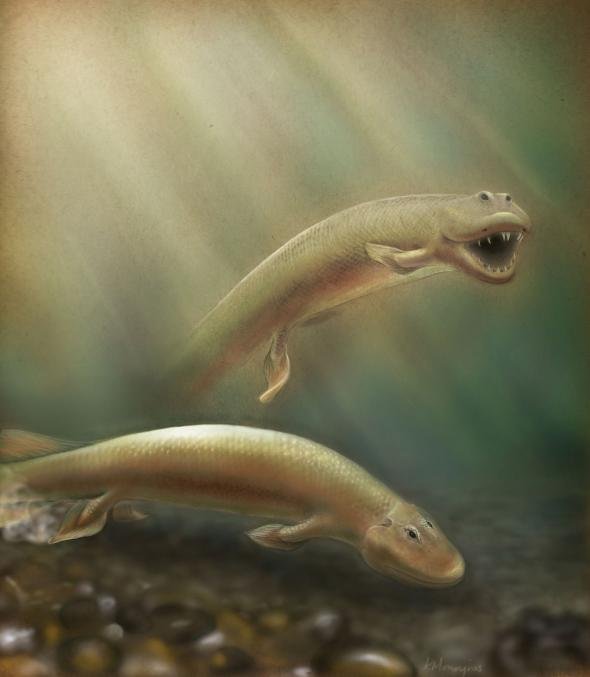Tiktaalik Roseae: A 375-Million-Year-Old Fish Had Fins For Walking
MessageToEagle.com – Tiktaalik Roseae was a 375-million-year-old crocodile-like fish that could grow up to nine feet in length and hunted in shallow freshwater environments. What is extraordinary about this animal is that the fish had fins for walking. Tiktaalik Roseae, better known as the “fishapod it is the best representation of transitional species between fish and land-dwelling tetrapods.
Tiktaalik means “large, freshwater fish” in the language of the Nunavut people, who live in the region near its discovery site on Canada’s frigid Ellesmere Island.
Tiktaalik Roseae lived in marshy river settings resembling today’s Amazon.
A series of discoveries, including Tiktaalik and similar creatures over the past decade, are giving scholars opportunity to learn when animals, other than insects first made the leap to land.

ILLUSTRATION BY KALLIOPI MONOYIOS
Why fish made the move to land 395 million years ago remains a bit of a mystery. It was very long time ago the ancient supercontinent of Gondwana was drifting toward the proto-North American continent.
See also: Pristimantis Mutabilis: Shape-Shifting Frog In The Ecuadorian Cloud Forest
During this drift created many shallow-water habitats, hence perfect places for something crocodile-like to thrive. These environments were also at the equator at that time, so it is nice and warm and tropical.
The problem was food. But there was not much to eat on land at the time for Tiktaalik, aside from spiders, scorpions, insects, and a few plants. Fewer predators or a safer place to lay eggs may have instead driven land creatures to evolve, some suggest.
MessageToEagle.com
Related Posts
-
 Earth Compared To A Giant Solar Flare Eruption
No Comments | Aug 5, 2016
Earth Compared To A Giant Solar Flare Eruption
No Comments | Aug 5, 2016 -
 Smith Cloud: Science Facts About Giant Gas Cloud On Collision Course With Milky Way
No Comments | Feb 6, 2016
Smith Cloud: Science Facts About Giant Gas Cloud On Collision Course With Milky Way
No Comments | Feb 6, 2016 -
 Illuminati: Facts And History About The Secret Society
No Comments | Mar 30, 2017
Illuminati: Facts And History About The Secret Society
No Comments | Mar 30, 2017 -
 Susa: One Of The World’s Oldest Cities That Served As Capital Of The Elamite Empire
No Comments | Nov 21, 2023
Susa: One Of The World’s Oldest Cities That Served As Capital Of The Elamite Empire
No Comments | Nov 21, 2023 -
 ‘Artificial Trees’ Will Absorb Carbon Dioxide 1,000 Times More Effective Than A Regular Tree
No Comments | Feb 9, 2016
‘Artificial Trees’ Will Absorb Carbon Dioxide 1,000 Times More Effective Than A Regular Tree
No Comments | Feb 9, 2016 -
 Black Plants Could Exist On Alien Worlds With Two Suns
No Comments | Dec 8, 2015
Black Plants Could Exist On Alien Worlds With Two Suns
No Comments | Dec 8, 2015 -
 Reincarnation – Journey Of The Souls And Our Karma We Depend On In The Next Life
No Comments | Aug 2, 2018
Reincarnation – Journey Of The Souls And Our Karma We Depend On In The Next Life
No Comments | Aug 2, 2018 -
 Do We Live In A Computer Simulation Created By An Advanced Alien Civilization?
No Comments | Sep 7, 2013
Do We Live In A Computer Simulation Created By An Advanced Alien Civilization?
No Comments | Sep 7, 2013 -
 10 Fascinating Facts About Plants
No Comments | Aug 2, 2016
10 Fascinating Facts About Plants
No Comments | Aug 2, 2016 -
 The Higgs Particle Could Have Ended The Universe By Now – Here’s Why We’re Still Here
No Comments | Aug 22, 2024
The Higgs Particle Could Have Ended The Universe By Now – Here’s Why We’re Still Here
No Comments | Aug 22, 2024
